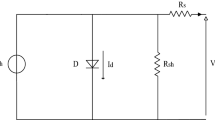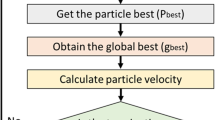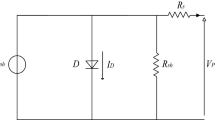Abstract
The main objective of this study is to examine the feasibility of hybrid PSO–ANN technique to estimate the exergetic performance of a building integrated photovoltaic/thermal (BIPV/T) system. A performance evaluation criterion (PEC) is defined in this study to assess the overall performance of a BIPV/T system from exergy point of view. Then, the mentioned method is utilized to identify a relationship between the input and output parameters of the BIPV/T system. The parameter PEC was taken as the essential output of the BIPV/T system, while the input parameters were channel length, channel depth, channel width, and air mass flow rate. Prior to PSO, variables of ANN algorithm were optimized. In addition, PSO influential parameters such as swarm size, personal learning coefficient, global learning coefficient, and inertia weight were optimized using a series of trial-and-error process. The predicted results for data sets from ANN and PSO–ANN models were evaluated according to several known statistical indices and novel ranking systems of color intensity rating and total ranking method. The obtained RMSE and R2 in the training (RMSE of 0.010274 and 0.006112, and R2 of 0.9968 and 0.9989, respectively, for the PSO and ANN methods) and testing (RMSE of 0.011146 and 0.005927, and R2 of 0.9967 and 0.9990, respectively, for the PSO and ANN methods) phases. The results revealed that the PSO–ANN network model could slightly accomplish a better performance when it is compared to the conventional ANN.













Similar content being viewed by others
Abbreviations
- \({C_{\text{P}}}\) :
-
Specific heat capacity of air (J kg− 1 K− 1)
- \({D_{\text{H}}}\) :
-
Hydraulic diameter of PV duct located behind the PV modules (m)
- \({h_{\text{c}}}\) :
-
Convective heat exchange coefficient (W K− 1 m− 2)
- \({h_{{\text{r}},{\text{pv}} - {\text{b}}}}\) :
-
Radiative heat exchange coefficient from PV modules to insulation wall (W K− 1 m− 2)
- \({h_{{\text{r}},{\text{pv}} - {\text{s}}}}\) :
-
Radiative heat exchange coefficient between PV modules and sky (W K− 1m− 2)
- \({h_{\text{w}}}\) :
-
Heat transfer coefficient of wind (W Km− 2)
- \({I_{\text{r}}}\) :
-
Intensity of solar radiation (W m− 2)
- K :
-
Thermal conductivity of air (W m− 1 K−)
- \({k_{{\text{ins}}}}\) :
-
Thermal conductivity of insulation material (W m− 1 K− 1)
- \(L\) :
-
Duct length (m)
- \({\dot {m}_{\text{f}}}\) :
-
Mass flow rate of air (kg s− 1)
- PEC:
-
Performance evaluation criterion
- \(\Delta p\) :
-
Pressure loss (Pa)
- Pr:
-
Prandtl number
- Re:
-
Reynolds number
- S :
-
Duct depth (m)
- Ta:
-
Temperature of outdoor air (K)
- Tb:
-
Temperature of insulation wall (K)
- Tf:
-
Temperature of flowing air in the duct (K)
- \({T_{{\text{in}}}}\) :
-
Temperature of air entering the duct (K)
- \({T_{{\text{mf}}}}\) :
-
Mean air temperature (K)
- Tpv:
-
PV module temperature (K)
- Ub:
-
Back-loss coefficient (W K− 1m− 2)
- vw:
-
Wind velocity (m s− 1)
- W :
-
Duct width (m)
- \({\dot {X}_{{\text{air}},{\text{in}}}}\) :
-
Exergy of air entering the duct (kWh)
- \({\dot {X}_{{\text{air}},{\text{out}}}}\) :
-
Exergy of air leaving the duct (kWh)
- \({\dot {X}_{{\text{dest}}}}\) :
-
Exergy destructed from the collector (kWh)
- \({\dot {X}_{{\text{el}},{\text{PV}}}}\) :
-
Exergy of electricity produced by PV modules (kWh)
- \({\dot {X}_{{\text{fan}}}}\) :
-
Exergy of electricity consumed by fans (kWh)
- \({\dot {X}_{\text{r}}}\) :
-
Exergy load of the external air (kWh): solar radiation exergy (kWh)
- \({\dot {X}_{{\text{th}}}}\) :
-
Thermal exergy output (kWh)
- \({\alpha _{{\text{pv}}}}\) :
-
Sorptance of PV modules
- \({\delta _{{\text{ins}}}}\) :
-
Thickness of insulation material (m)
- \({\varepsilon _{{\text{pv}}}}\) :
-
Emissivity of PV module
- \({\eta _{{\text{el}}}}\) :
-
Electrical conversion efficiency of PV modules
- \({\eta _{{\text{fan}}}}\) :
-
Fan efficiency
- \(\rho\) :
-
Air density (kg m− 3)
- \(\sigma\) :
-
Stefan–Boltzmann constant (5.67 × 10− 8 W m− 2 K− 4)
References
https://www.energy.gov/eere/solar/crystalline-silicon-photovoltaics-research
Shahsavar A, Rahimi Z, Salehipour H (2019) Nanoparticle shape effects on thermal-hydraulic performance of boehmite alumina nanofluid in a horizontal double-pipe minichannel heat exchanger. Heat Mass Transfer. https://doi.org/10.1007/s00231-018-02558-x
Shahsavar A, Godini A, Talebizadeh Sardari P, Toghraie D, Salehipour H (2019) Effect of variable thermal conductivity and viscosity of Fe3O4-CNT/water hybrid nanofluid on the thermal-hydraulic performance of a minichannel heat exchanger. J Therm Anal Calorim 135:1–13. https://doi.org/10.1007/s10973-018-07997-6
Shahsavar A, Godini A, Toghraie D (2019) Free convection heat transfer and entropy generation analysis of water-Fe3O4/CNT hybrid nanofluid in a concentric annulus. Int J Numer Meth Heat Fluid Flow 29(3):915–934. https://doi.org/10.1108/HFF-08-2018-0424
Monfared M, Shahsavar A, Bahrebar MR (2019) Second law analysis of turbulent convection flow of boehmite alumina nanofluid inside a double-pipe heat exchanger considering various shapes for nanoparticle. J Therm Anal Calorim 135(2):1521–1532. https://doi.org/10.1007/s10973-018-7708-7
Shahsavar A, Al-Rashed AAAA, Entezari S, Talebizadeh Sardari P (2019) Melting and solidification characteristics of a double-pipe latent heat storage system with sinusoidal wavy channels embedded in a porous medium. Energy 171:751–769
Alsarraf J, Moradikazerouni A, Shahsavar A, Afrand M, Salehipour H, Tran MD (2019) Hydrothermal analysis of turbulent boehmite alumina nanofluid flow with different nanoparticle shapes in a minichannel heat exchanger using two-phase mixture model. Phys A 520:275–288
Alnaqi AA, Moayedi H, Shahsavar A, Nguyen TK (2019) Prediction of energetic performance of a building integrated photovoltaic/thermal system thorough artificial neural network and hybrid particle swarm optimization models. Energy Convers Manag 183:137–148
Hebb D (1949) The organization of behavior: a neurophysiological approach. Wiley, Hoboken
Bahiraei M, Godini A, Shahsavar A (2018) Thermal and hydraulic characteristics of a minichannel heat exchanger operated with a non-Newtonian hybrid nanofluid. J Taiwan Inst Chem Eng 84:149–161
Shahsavar A, Talebizadeh P, Tabaei H (2013) Optimization with genetic algorithm of a PV/T air collector with natural air flow and a case study. J Renew Sustain Energy 5:023118
Ameri M, Mahmoudabadi MM, Shahsavar A (2012) An experimental study on a PV/T air collector with direct coupling of fans and panels. Energy Sources Part A 34:929–947
Shahsavar A, Ameri M (2010) Experimental investigation and modeling of a direct-coupled PV/T air collector. Sol Energy 84:1938–1958
Gandjalikhan Nassab SA, Shahsavar A, Moghimi MA (2012) Analysis of combined conduction and radiation heat transfer in a rectangular furnace including two heat sources. Int J Eng 25:65–70
Shahsavar A, Khanmohammadi S (2019) Feasibility of a hybrid BIPV/T and thermal wheel system for exhaust air heat recovery: energy and exergy assessment and multi-objective optimization. Appl Therm Eng 146:104–122
Shahsavar A, Bahiraei M, Ansarian R (2018) Effect of line dipole magnetic field on entropy generation of Mn-Zn ferrite ferrofluid flowing through a minichannel using two-phase mixture model. Powder Technol 340:370–379
Moayedi H (2018) Optimization of ANFIS with GA and PSO estimating α in driven shafts. Eng Comput 35:1–12
Moayedi H, Mosallanezhad M, Mehrabi M, Safuan ARA, Biswajeet P (2018) Modification of landslide susceptibility mapping using optimized PSO–ANN technique. Eng Comput 35:1–18
Asadi A, Moayedi H, Huat BB, Boroujeni FZ, Parsaie A, Sojoudi S (2011) Prediction of zeta potential for tropical peat in the presence of different cations using artificial neural networks. Int J Electrochem Sci 6:1146–1158
Gao W, Wu H, Siddiqui MK, Baig AQ (2018) Study of biological networks using graph theory. Saudi J Biol Sci 25:1212–1219
Asadi A, Moayedi H, Huat BBK, Parsaie A, Taha MR (2011) Artificial neural networks approach for electrochemical resistivity of highly organic soil. Int J Electrochem Sci 6:1135–1145
Gao W, Wang W, Dimitrov D, Wang Y (2018) Nano properties analysis via fourth multiplicative ABC indicator calculating. Arab J Chem 11:793–801
Moayedi H, Hayati S (2018) Artificial intelligence design charts for predicting friction capacity of driven pile in clay. Neural Comput Appl. https://doi.org/10.1007/s00521-018-3555-5
Moayedi H, Hayati S (2018) Applicability of a CPT-Based Neural Network Solution in Predicting Load-Settlement Responses of Bored Pile. Int J Geomech 18:1–11. https://doi.org/10.1061/(ASCE)GM.1943-5622.0001125
Moayedi H, Hayati S (2018) Modelling and optimization of ultimate bearing capacity of strip footing near a slope by soft computing methods. Appl Soft Comput 66:208–219
Gao W, Guirao JLG, Basavanagoud B, Wu J (2018) Partial multi-dividing ontology learning algorithm. Inf Sci 467:35–58
Moayedi H, Armaghani DJ (2017) Optimizing an ANN model with ICA for estimating bearing capacity of driven pile in cohesionless soil. Eng Comput 1–10
Nguyen H, Bui X-N, Bui H-B, Mai N-L (2018) A comparative study of artificial neural networks in predicting blast-induced air-blast overpressure at Deo Nai open-pit coal mine, Vietnam. Neural Comput Appl 31:1–17. https://doi.org/10.1007/s00521-018-3717-5
Nguyen H, Bui X-N (2018) Predicting blast-induced air overpressure: a robust artificial intelligence system based on artificial neural networks and random forest. Nat Resour Res:1–15. https://doi.org/10.1007/s11053-018-9424-1
Gao W, Guirao JLG, Abdel-Aty M, Xi W (2019) An independent set degree condition for fractional critical deleted graphs. Discrete Cont Dyn Syst S 12:877–886
Hoang N, Xuan-Nam B, Quang-Hieu T, Ngoc-Luan M (2019) A new soft computing model for estimating and controlling blast-produced ground vibration based on hierarchical K-means clustering and cubist algorithms. Appl Soft Comput 77:376–386. https://doi.org/10.1016/j.asoc.2019.01.042
Nguyen H, Bui X-N, Tran Q-H, Le T-Q, Do N-H, Hoa LTT (2018) Evaluating and predicting blast-induced ground vibration in open-cast mine using ANN: a case study in Vietnam. SN Appl Sci. https://doi.org/10.1007/s42452-018-0136-2
Bui X-N, Nguyen H, Le H-A, Bui H-B, Do N-H (2019) Prediction of blast-induced air over-pressure in open-pit mine: assessment of different artificial intelligence techniques. Nat Resour Res 2019:1–21. https://doi.org/10.1007/s11053-019-09461-0
Gao W, Dimitrov D, Abdo H (2018) Tight independent set neighborhood union condition for fractional critical deleted graphs and ID deleted graphs. Discrete & continuous dynamical systems-S 123–144
McCulloch WS, Pitts W (1943) A logical calculus of the ideas immanent in nervous activity. Bull Math Biophys 5(4):115–133
Author information
Authors and Affiliations
Corresponding author
Ethics declarations
Conflict of interest
Authors declare no conflict of interest.
Additional information
Publisher’s Note
Springer Nature remains neutral with regard to jurisdictional claims in published maps and institutional affiliations.
Rights and permissions
About this article
Cite this article
Alsarraf, J., Moayedi, H., Rashid, A.S.A. et al. Application of PSO–ANN modelling for predicting the exergetic performance of a building integrated photovoltaic/thermal system. Engineering with Computers 36, 633–646 (2020). https://doi.org/10.1007/s00366-019-00721-4
Received:
Accepted:
Published:
Issue Date:
DOI: https://doi.org/10.1007/s00366-019-00721-4




